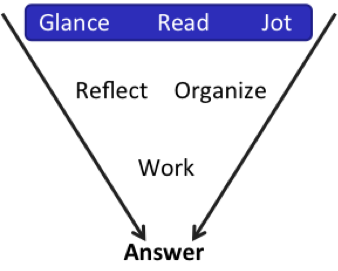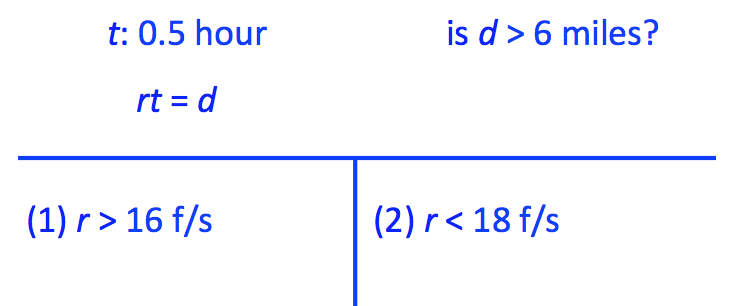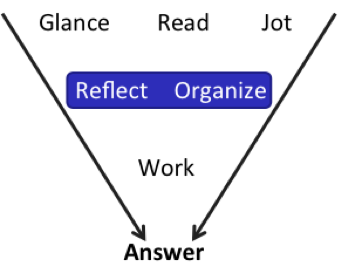-
Target Test Prep 20% Off Flash Sale is on! Code: FLASH20
Redeem
Avoiding Calculations on GMAT Data Sufficiency
 The beautiful thing about Data Sufficiency is that were allowed not to do all of the calculations that a Problem Solving problem might require. Still, leave it to the GMAT to try to suck you into doing more than you need to do in order to get to the answer.
The beautiful thing about Data Sufficiency is that were allowed not to do all of the calculations that a Problem Solving problem might require. Still, leave it to the GMAT to try to suck you into doing more than you need to do in order to get to the answer.
Normally, I just toss you into a problem and then we discuss, but today Im going to warn you: the GMATPrep problem that Im about to give you is going to do its best to make you waste time. As you try this problem, ask yourself, Do I really need to do that calculation? Is there an easier way?
Try this problem from the GMATPrep free exams.
*If it took Carlos hour to cycle from his house to the library yesterday, was the distance that he cycled greater than 6 miles? (Note: 1 mile = 5,280 feet)(1) The average speed at which Carlos cycled from his house to the library yesterday was greater than 16 feet per second.
(2) The average speed at which Carlos cycled from his house to the library yesterday was less than 18 feet per second.
(I haven't put in the DS answer choices. If you don't know DS well enough to know what the answer choices are already, come back to this article later.)
Ready? Okay, first, lets understand whats going on.
Glance: DS. Story problem. 1 mile = 5,280 feet catches my eye and my immediate reaction is Ugh followed by I am not converting stuff in this problem! No thank you!
(Note: I havent even read the problem yet. Im just annoyed by the idea of conversion in general, and this is DS, so Im going to do my best to find a way around it.)
Read: C bicycles for half an hour. The question is an inequality interesting. Its a yes/no question.
Jot:
Note that I did not jot down the conversion from miles to feet. Im still determined to avoid having to use that!
Next, I need to think about how to approach this in order to minimize my calculations. Theres not a lot I can do with the question stem, so its time to look at the statements.
What now? Think before you work.
Hmm. Each statement is an inequality. Annoyingly, the rate is in feet per second, even though the question stem talks about biking for half an hour. Another conversion!
Okay, think about this. If they gave me an exact number for the rate, I could of course solve. But they only told me that the rate is greater than 16f/s (for statement 1).
On Data Sufficiency, when they give you an inequality with a yes/no question, the task is to figure out whether the range of possible values is going to give you one definitive answer (either Always Yes or Always No = sufficient), or whether that range will permit a Sometimes Yes, Sometimes No situation (= insufficient).
The key is to test the limit: the integer at the outside edge of the range (even if it is not included in the range!). For statement (1), that means testing r = 16 f/s. If that rate already means that the distance is greater than 6 miles, then all higher rates will also result in a distance greater than 6 miles.
If, on the other hand, r = 16f/s results in a distance of less than 6 miles, then some higher rates will return that same result but once the rate gets high enough, the distance will become greater than 6 miles.
Try it out.
Statement (1) : r > 16 f/s
Try r = 16 f/s
Convert to feet per half hour, since we know Carlos rides for half an hour:
=(16 f/sec)(60 sec/min)(30 min/ half hour)
move some zeroes around to get:
=(1600)(18)
Now pause again and think about how to avoid multiplying that out. Also, glance at the conversion for miles to feet: 1 mile = 5,280 feet.
Feet to miles feet to miles how to get from feet to miles?
Try multiples of 1600 until you get closer to 1 mile, or 5,280 feet.
1600
3200
4800
Hmm. (1600)(3) = 4800, which is a bit less than 1 mile. But Ive only multiplied by 3 so far. I also still have a 6 that I need to multiply by, since 18 = (3)(6).
In other words, I have to do this (1600)(3) calculation 6 times. Brainstorm!! The question asked whether he went more than 6 miles. Check this out:
1600(3) = 4800 which is < 1 mi
1600(3) = 4800 which is < 1 mi
1600(3) = 4800 which is < 1 mi
1600(3) = 4800 which is < 1 mi
1600(3) = 4800 which is < 1 mi
1600(3) = 4800 which is < 1 mi
I have to do the calculation 6 times and Carlos is about 500 feet under a mile each time, so he will be decently below 6 miles at this rate. (You dont need to write out all 6 lines. Im just trying to illustrate the pattern.)
What happens when the rate increases?
At a rate of 16.00001 f/s, Carlos is still going to be under 6 miles. But if that rate gets up to, say, 100 f/s, hes going to travel more than 6 miles.
Statement (1) is not sufficient to answer the question. Eliminate answers (A) and (D).
Try the same shortcut for the next statement
Statement (2) : r < 18 f/s
Try r = 18 f/s
Convert to feet per half hour again and rearrange the zeros:
=(18 f/sec)(60 sec/min)(30 min/ half hour)
=(1800)(18)
Hmm.
1800
3600
5400
This time, multiplying by 3 puts Carlos over 1 mile! So if he does this 6 times, thats going to be over 6 miles.
Again, at 17.99999 f/s, Carlos is still going to be over 6 miles. But we know that if he gets down as far as 16 f/s, hell be under 6 miles.
Statement (2) is also not sufficient; eliminate answer (B).
What happens when you put the two statements together?
Carlos is traveling somewhere between 16 and 18 f/s. If hes just a little over 16 f/s, then hes going to travel fewer than 6 miles. But if he makes it to just under 18 f/s, hes going to be over 6 miles.
Even together, the two statements are not sufficient to answer the question.
The correct answer is (E).
How did I know to break the numbers down exactly the way I did?
I didnt! I just knew that I wanted to avoid some annoying calculations if possible, so I started looking for ways to approximate what I needed. I wrote out the calculations exactly as I put them up aboveand suddenly I had my Eureka! moment and realized that my approximations were good enough.
What if that hadnt worked? I wouldve shrugged my shoulders, picked my favorite letter (B, for the record), and moved on. Id rather do that than get super aggravated trying to convert and do all those calculations by hand.
Key Takeaways for Avoiding Calculations on DS:
(1) Let your annoyances work for you. That conversion was one of the first things I noticed, and I hate conversions. (Who doesnt?) So, from the beginning, I decided that I was committing myself to a no annoying math pathway for the problem. (See #3 for more on this.)
(2) When I committed to my minimal math path, I knew I wouldnt have time to go back to the beginning and do all of the real calculations if the minimal path didnt work out. And I was okay with that. Dont be afraid to guess and move on. Business mindset: some opportunities arent worth it.
(3) Do set up the beginning math, but dont automatically do the calculations. I knew I had no interest in multiplying out (16)(60)(30)and then doing a feet to miles conversion on top of that!but looking at the math written out gave me an idea about how to approximate my way to an answer.
* GMATPrep questions courtesy of the Graduate Management Admissions Council. Usage of this question does not imply endorsement by GMAC.
>>Click here to learn how to avoid calculations on Problem Solving.
Recent Articles
Archive
- April 2024
- March 2024
- February 2024
- January 2024
- December 2023
- November 2023
- October 2023
- September 2023
- July 2023
- June 2023
- May 2023
- April 2023
- March 2023
- February 2023
- January 2023
- December 2022
- November 2022
- October 2022
- September 2022
- August 2022
- July 2022
- June 2022
- May 2022
- April 2022
- March 2022
- February 2022
- January 2022
- December 2021
- November 2021
- October 2021
- September 2021
- August 2021
- July 2021
- June 2021
- May 2021
- April 2021
- March 2021
- February 2021
- January 2021
- December 2020
- November 2020
- October 2020
- September 2020
- August 2020
- July 2020
- June 2020
- May 2020
- April 2020
- March 2020
- February 2020
- January 2020
- December 2019
- November 2019
- October 2019
- September 2019
- August 2019
- July 2019
- June 2019
- May 2019
- April 2019
- March 2019
- February 2019
- January 2019
- December 2018
- November 2018
- October 2018
- September 2018
- August 2018
- July 2018
- June 2018
- May 2018
- April 2018
- March 2018
- February 2018
- January 2018
- December 2017
- November 2017
- October 2017
- September 2017
- August 2017
- July 2017
- June 2017
- May 2017
- April 2017
- March 2017
- February 2017
- January 2017
- December 2016
- November 2016
- October 2016
- September 2016
- August 2016
- July 2016
- June 2016
- May 2016
- April 2016
- March 2016
- February 2016
- January 2016
- December 2015
- November 2015
- October 2015
- September 2015
- August 2015
- July 2015
- June 2015
- May 2015
- April 2015
- March 2015
- February 2015
- January 2015
- December 2014
- November 2014
- October 2014
- September 2014
- August 2014
- July 2014
- June 2014
- May 2014
- April 2014
- March 2014
- February 2014
- January 2014
- December 2013
- November 2013
- October 2013
- September 2013
- August 2013
- July 2013
- June 2013
- May 2013
- April 2013
- March 2013
- February 2013
- January 2013
- December 2012
- November 2012
- October 2012
- September 2012
- August 2012
- July 2012
- June 2012
- May 2012
- April 2012
- March 2012
- February 2012
- January 2012
- December 2011
- November 2011
- October 2011
- September 2011
- August 2011
- July 2011
- June 2011
- May 2011
- April 2011
- March 2011
- February 2011
- January 2011
- December 2010
- November 2010
- October 2010
- September 2010
- August 2010
- July 2010
- June 2010
- May 2010
- April 2010
- March 2010
- February 2010
- January 2010
- December 2009
- November 2009
- October 2009
- September 2009
- August 2009



